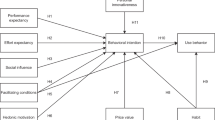Abstract
In the design of a Telematic Learning Environment (TLE) in which student teachers learn collaboratively, we consider three clusters of design elements as important: the Telematic Work Environment, the guidance of the instructor and the task instruction. We will have a look at the way group and task behaviour, triggered by these design elements influence the collaborative outcomes. Experiments have revealed that the technical environment is not as important as we had expected beforehand. This research shows that the task instruction (pre-imposed structure, role taking and intrinsic motivation for the task) and the group process itself have far more impact on the online collaborative work of the student teachers.
Similar content being viewed by others
References
Cohen, E. G. (1994) Restructuring the classroom: Conditions for productive small groups. Review of Educational Research, 64(1), 1–35.
Johnson, D. W. and Johnson, R. T. (1994) Learning together. In Handbook of Co-operative Learning Methods, S. Sharan (ed). Greenwood Press, Westport, CT, pp. 51–65.
Kagan, S. (1994) Co-operative Learning. Moore Data Management Services, San Diego.
Lockhorst, D. (1999) Summary of the interviews. Internal report. IVLOS/Utrecht University, Utrecht, The Netherlands.
Lockhorst, D. (2000) Evaluatie Teleleren ICLON: Project Vuistregels. (Evaluation Telelearning at ICLON: Project Rules of Thumb.) IVLOS/Utrecht University, Utrecht, The Netherlands.
McIntyre, S. R. and Tlusty, R. H. (1995) Computer-mediated discourse: Electronic dialogue journaling and reflective practice. Paper presented at the AERA, San Fransisco.
Miller, N. and Harrington, H. J. (1992) Social categorization and intergroup acceptance: Principles for the design and development of cooperative learning teams. In Interaction in Cooperative groups, the Theoretical Anatomy of Group Learning, R. Hertz-Lazarowitz and N. Miller (eds). Cambridge University Press, Cambridge, pp. 203–225.
Strom, R. and Strom, P. (1996) Student evaluation of social skills. Journal of Instructional Psychology, 23(2), 111–117.
Author information
Authors and Affiliations
Rights and permissions
About this article
Cite this article
Lockhorst, D., Admiraal, W., Pilot, A. et al. Design Elements for a CSCL Environment in a Teacher Training Programme. Education and Information Technologies 7, 377–384 (2002). https://doi.org/10.1023/A:1020973823969
Issue Date:
DOI: https://doi.org/10.1023/A:1020973823969




